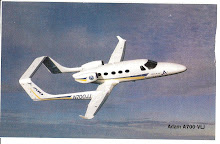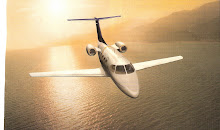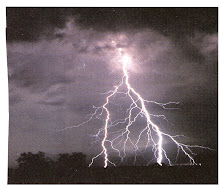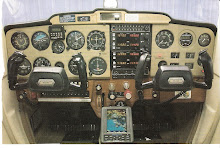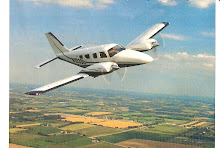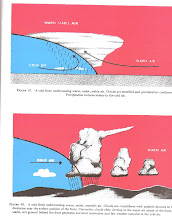Hi Readers: I ran across this in my notes during my present move to a new address - which is Standiford Place, 3420 Shawnee Dr., Apt 204, Modesto, CA. 95350
Here are some words of our aviation language, possibly more than familiar by now, sparked by WWII. The words developed mostly by necessity, maybe a time-saver, a quick look, a long glance, a link to the past, still a choice of the present - by love, anger, devotion, admiration, respect, and pride:
The Gooney bird, the Spruce Goose, it's a 2-winger, gimme 1/4 flaps, full bore, gimme ten, the Boxcar, 45 inches, gear down, Jimmy Doo, feather it!, and flaps coming up. Then there is Hap Arnold, head up your __, low pitch, flattop, Tokyo Rose, fly boy, ground-pounder, and Oh My GOD.
And you've heard of: Corn-cob engine, low-winger, plebe, 2-seater, hard landing, aviatrix, go-around, 4-seater, Tits Malloy, Rosie-the-Riveter, the skipper, the 'ole man, the black widow, "bubbles", and look at those boobs.
There were others, too: The Flying Wing, the Flying Tigers, the Hellcat, airhead, Kissin cousin, and geronimo. And then we had the CAP, the WACS, the Waves, the Wasps, and the WAFS. I'm sure you can think of others.
Thanks for listening. R.S.
Monday, April 28, 2008
Monday, April 21, 2008
March 2008 Accidents/Incidents - Part II
Hi Readers: Part II covers, primarily, the fatal and nonfatal accidents with indicated causes and analysis where possible. All told, Cessna Aircraft dominated the accident picture with 21 accidents/Incidents. And this would be expected since there are more Cessna aircraft flying in GA; also dominating the small jet inventory. In fact, Cessna Aircraft, owned by Textron, Inc. (a $10 Billion industry in 33 countries) is the largest manufacturer of GA airplanes. It is of note that Textron, Inc. also owns Bell Helicopter, Lycoming Engines, and other companies in the aviaation industry. Therefore, considering the exposure, we don't tag Textron or Cessna as a bad accident actor. The individual accident rates tell the story.
Of the fatal accidents, a Cessna 500 topped the list, on a day X-C flight after takeoff from Wiley Post airport at Oklahoma City, Oklahoma. The ATP instrument rated pilot and 3 passengers sustained fatal injuries. Loss of control and impact with terrain occurred under VFR conditions on an IFR flight plan. A qualified aviation witness indicated a right engine compressor stall, the aircraft descending 60-70 degrees nosedown and observed pieces of bird falling. A Cessna 172 accident followed with 4 fatalities on a day VFR bird survey flight, with loss of control and impact with the ground. The aircraft was observed in low flight to strike the ground under power. A 2 fatal Cessna T210M collided with terrain on an instrument X-C night flight from Baton Rouge to Lafayette, LA. The instrument rated pilot was receiving vectors for an instrument approach to R/W4R at Abbeville, La. The weather was reported as multi-layered clouds with heavy rain showers. A Canadian Cessna 182B impacted a swamp near Wilwood, FL. while maneuvering near a private ranch at night under VFR conditions. The non-instrument pilot and passenger sustained fatal injuries. The night was reported as dark, the ceiling between 800' and 1,000'. Another Cessna 172 crashed at Gun Barrel City, TX. after striking power lines on a day VFR flight from Athens, Tx. One fatal and one serious injury was reported.
A day ground collision occurred at Titusville, FL. airport when a Velocity XC RG aircraft and a Vans RV-8 came together on R/W 15 after landing in VFR conditions. Both aircraft were arriving for an Experimental Aircraft Association breakfast at Titusville. Four RV-8s had exited the runway at Intersection B after landing. The Veocity XC landed, following the 4 aircraft and departed the runway entering a grassy area separating R/W 15 and the taxiway. The pilot applied full power in a left bank (apparently trying to avoid the collision). The Velocity XL commercial pilot sustained serious injury and his passenger sustained fatal injuries. In the Vans RV 8 airplane that was struck, the ATP pilot and a pilot rated passenger received fatal injuries.
There were 3 Cirrus SR22 accidents during the period, one a non-U.S., losing power on a day takeoff and impacting a building. It was reported that the aircraft had been refueled with Jet A-1 instead of gasolene. The pilot and 3 passengers sustained fatal injuries. Another Cirrus SR22 aircraft impacted a mountain under power shortly after a marginal weather night takeoff on a X-C IFR flight plan flight to Baltimore from FT. Royal, VA. The elevation of the FT. Royal airport was 709' msl and the elevation of the mountain ridge was 1,200' msl. The pilot possessed a 3rd class medical certificate and had a total flight time of 180 hours; however he had an instrument rating. The reported weather was strictly IFR conditions. The aircraft was equipped with Engine Multifunction and Primary Flight Display. The pilot and a passenger sustained fatal injuris. One other Cirrus SR22 collided with trees on a day VFR approach to R/W6 at Weddington, NC. The pilot sustained fatal injuries.
There were 2 Mooney M20C accidents, both on day X-C flights. One was an inflight breakup of the aircraft offshore of the Grand Bahamas. Fishermen reported a loud noise and saw what appeared to be the engine and other components falling in the sky. The flight departed the Grand Bahamas Int'l airport en route to the ST. Lucie airport, FL. The pilot and a passenger sustained fatal injuries. The other Mooney M20C accident occurred near Atkins, VA., impacting terrain during an IFR flight from Charleston, West VA. to Jacksonville, FL. Cruising at 6,200' MSA (Minimum safe Altitude), the pilot reported icing and requested a lower altitude. Because of the MSA the Controller gave the pilot a 30 degree turn and asked if he would like to climb to 8,000' (another pilot 30 miles to the East reported cloud tops at 7,500'). The pilot reported that he would. Three minutes later the pilot advised that he was lossing altitude. There was no further communication. Radar data showed a climb to 6,500' before losing altitude. The crash site indicated a vertical descent. The Canadian pilot did not have an instrument rating. His total flight time was 327 hours, 10 hours of which was actual instrument flight. He had 10 hours of simulated instrument time. The weather was heavy IFR conditions.
A Ritter RV10 amateur-built aircraft impacted terrain, following loss of control in cruise flight near Ledbetter, Tx. The weather was VFR conditions. The pilot sustained fatal injuries. A Jenkins RV7 experimental aircraft crashed on a VFR day flight on takeoff at Winslow, AZ. The aircraft climbed nosehigh, rolled left, and struck the ground nose low. The pilot lost control and sustained fatal injuries. This was the first flight since engine repair. A PA-28-161 impacted water shortly after takeoff from Venice, FL. during night VFR conditions. This was the commercial pilot's first flight at night in the aircraft after a day checkout. The pilot sustained fatal injuries.
There were 44 nonfatal accidents, including one Bell 206B helicopter. The nonfatal accidents represented a myriad of GA aircraft types, including 11 Cessna types (one 525B Citation), 4 Piper types, 2 Beech types, 2 Diamond aircraft types, a Great Lakes aircraft, 6 helicopters, 2 Maule M4's, and a host of other types (12). There was one interesting accident at Tracy, CA. A certified flight instructor, with a student, was demonstrating an engine failure during takeoff initial climb by executing an 180-degree turn back to the airport. He then initiated a go-around by applying full power. The airplane, an American Champion 7GCAA, stalled and impacted the runway.
The indicated causes of the nonfatal accidents seemed to cluster around the landing, go-around, and approach phases of flight, associated with engine failure and loss of power, and X-wind conditions leading to loss of control. There were 9 accidents the direct result of x-wind conditions, 8 airplane hard landings (3 helicopters incurring hard landings after an initial problem), 5 forced landings due to loss of engine power, one forced landing due to fuel exhaustion (the pilot forgot to switch fuel tanks), 4 gear collapses on landing, 3 gear up landings (one at night), one aborted takeoff, one stalled on takeoff, several component failures such as malfunction of brakes, inflight separation of nosewheel, one partial rudder separation in flight, and 2 landing short of the runway due to wind shear.
One pilot attempted to land in a 90-degree x-wind and was swept off the runway. And one lucky pilot, departing on a night solo flight, encountered IFR weather conditions, became lost, and was forced down by impact with high terrain. The pilot was found several days later, after dispensing flares. He did not remember the impact.
There was one Hot Air Balloon accident, the balloon forced down by strong winds to a hard landing, then catching fire. There were several serious injuries.
The nonfatal accidents indicated a lack of proficiency, poor judgment, lack of flight planning, and non-use of a checklist.
Thanks for listening. R.S.
Of the fatal accidents, a Cessna 500 topped the list, on a day X-C flight after takeoff from Wiley Post airport at Oklahoma City, Oklahoma. The ATP instrument rated pilot and 3 passengers sustained fatal injuries. Loss of control and impact with terrain occurred under VFR conditions on an IFR flight plan. A qualified aviation witness indicated a right engine compressor stall, the aircraft descending 60-70 degrees nosedown and observed pieces of bird falling. A Cessna 172 accident followed with 4 fatalities on a day VFR bird survey flight, with loss of control and impact with the ground. The aircraft was observed in low flight to strike the ground under power. A 2 fatal Cessna T210M collided with terrain on an instrument X-C night flight from Baton Rouge to Lafayette, LA. The instrument rated pilot was receiving vectors for an instrument approach to R/W4R at Abbeville, La. The weather was reported as multi-layered clouds with heavy rain showers. A Canadian Cessna 182B impacted a swamp near Wilwood, FL. while maneuvering near a private ranch at night under VFR conditions. The non-instrument pilot and passenger sustained fatal injuries. The night was reported as dark, the ceiling between 800' and 1,000'. Another Cessna 172 crashed at Gun Barrel City, TX. after striking power lines on a day VFR flight from Athens, Tx. One fatal and one serious injury was reported.
A day ground collision occurred at Titusville, FL. airport when a Velocity XC RG aircraft and a Vans RV-8 came together on R/W 15 after landing in VFR conditions. Both aircraft were arriving for an Experimental Aircraft Association breakfast at Titusville. Four RV-8s had exited the runway at Intersection B after landing. The Veocity XC landed, following the 4 aircraft and departed the runway entering a grassy area separating R/W 15 and the taxiway. The pilot applied full power in a left bank (apparently trying to avoid the collision). The Velocity XL commercial pilot sustained serious injury and his passenger sustained fatal injuries. In the Vans RV 8 airplane that was struck, the ATP pilot and a pilot rated passenger received fatal injuries.
There were 3 Cirrus SR22 accidents during the period, one a non-U.S., losing power on a day takeoff and impacting a building. It was reported that the aircraft had been refueled with Jet A-1 instead of gasolene. The pilot and 3 passengers sustained fatal injuries. Another Cirrus SR22 aircraft impacted a mountain under power shortly after a marginal weather night takeoff on a X-C IFR flight plan flight to Baltimore from FT. Royal, VA. The elevation of the FT. Royal airport was 709' msl and the elevation of the mountain ridge was 1,200' msl. The pilot possessed a 3rd class medical certificate and had a total flight time of 180 hours; however he had an instrument rating. The reported weather was strictly IFR conditions. The aircraft was equipped with Engine Multifunction and Primary Flight Display. The pilot and a passenger sustained fatal injuris. One other Cirrus SR22 collided with trees on a day VFR approach to R/W6 at Weddington, NC. The pilot sustained fatal injuries.
There were 2 Mooney M20C accidents, both on day X-C flights. One was an inflight breakup of the aircraft offshore of the Grand Bahamas. Fishermen reported a loud noise and saw what appeared to be the engine and other components falling in the sky. The flight departed the Grand Bahamas Int'l airport en route to the ST. Lucie airport, FL. The pilot and a passenger sustained fatal injuries. The other Mooney M20C accident occurred near Atkins, VA., impacting terrain during an IFR flight from Charleston, West VA. to Jacksonville, FL. Cruising at 6,200' MSA (Minimum safe Altitude), the pilot reported icing and requested a lower altitude. Because of the MSA the Controller gave the pilot a 30 degree turn and asked if he would like to climb to 8,000' (another pilot 30 miles to the East reported cloud tops at 7,500'). The pilot reported that he would. Three minutes later the pilot advised that he was lossing altitude. There was no further communication. Radar data showed a climb to 6,500' before losing altitude. The crash site indicated a vertical descent. The Canadian pilot did not have an instrument rating. His total flight time was 327 hours, 10 hours of which was actual instrument flight. He had 10 hours of simulated instrument time. The weather was heavy IFR conditions.
A Ritter RV10 amateur-built aircraft impacted terrain, following loss of control in cruise flight near Ledbetter, Tx. The weather was VFR conditions. The pilot sustained fatal injuries. A Jenkins RV7 experimental aircraft crashed on a VFR day flight on takeoff at Winslow, AZ. The aircraft climbed nosehigh, rolled left, and struck the ground nose low. The pilot lost control and sustained fatal injuries. This was the first flight since engine repair. A PA-28-161 impacted water shortly after takeoff from Venice, FL. during night VFR conditions. This was the commercial pilot's first flight at night in the aircraft after a day checkout. The pilot sustained fatal injuries.
There were 44 nonfatal accidents, including one Bell 206B helicopter. The nonfatal accidents represented a myriad of GA aircraft types, including 11 Cessna types (one 525B Citation), 4 Piper types, 2 Beech types, 2 Diamond aircraft types, a Great Lakes aircraft, 6 helicopters, 2 Maule M4's, and a host of other types (12). There was one interesting accident at Tracy, CA. A certified flight instructor, with a student, was demonstrating an engine failure during takeoff initial climb by executing an 180-degree turn back to the airport. He then initiated a go-around by applying full power. The airplane, an American Champion 7GCAA, stalled and impacted the runway.
The indicated causes of the nonfatal accidents seemed to cluster around the landing, go-around, and approach phases of flight, associated with engine failure and loss of power, and X-wind conditions leading to loss of control. There were 9 accidents the direct result of x-wind conditions, 8 airplane hard landings (3 helicopters incurring hard landings after an initial problem), 5 forced landings due to loss of engine power, one forced landing due to fuel exhaustion (the pilot forgot to switch fuel tanks), 4 gear collapses on landing, 3 gear up landings (one at night), one aborted takeoff, one stalled on takeoff, several component failures such as malfunction of brakes, inflight separation of nosewheel, one partial rudder separation in flight, and 2 landing short of the runway due to wind shear.
One pilot attempted to land in a 90-degree x-wind and was swept off the runway. And one lucky pilot, departing on a night solo flight, encountered IFR weather conditions, became lost, and was forced down by impact with high terrain. The pilot was found several days later, after dispensing flares. He did not remember the impact.
There was one Hot Air Balloon accident, the balloon forced down by strong winds to a hard landing, then catching fire. There were several serious injuries.
The nonfatal accidents indicated a lack of proficiency, poor judgment, lack of flight planning, and non-use of a checklist.
Thanks for listening. R.S.
Wednesday, April 16, 2008
March 2008 Aircraft Accidents and Incidents - Part I
Hi Readers: There was a total of 64 accidents/Incidents for March 2008 as reported by NTSB (National Transportation Safety Board). As of 4-16-08 the 19th and 23rd were unreported. There were 5 incidents, 15 fatal accidents with 35 fatalities, and 43 nonfatal accidents. There were 3 non-U.S. accidents, one public-use accident, 4 Part 137 accidents, 4 Part 135 accidents, 3 Part 121 accidents, and 49 accidents classified as GA accidents.
There were 7 helicopter accidents reported, the most serious accident (10 fatal) occurring 10 miles west of Santa Cruz, Peru when a Bell 412 EP, piloted by a U.S. certified air transport pilot and a peruvian provisional copilot, impacted mountainous terrain. There were two other Bell 206B accidents, one (2 minor injuries) in Alaska colliding with terrain - an aerial photography flight involving a loss of control while covering a dogsled race; the other, an agriculture flight, the skids contacting a field while spraying. There were 2 Robinson R22 helicopter accidents, one fatal - a combination photo and student training lesson, when the helicopter was observed to shed parts at low altitude and impact the ground. The tail cone had separated from the fuselage at a "right angle" and the main rotor blades exhibited "coning". Also, one of the main rotor blade sections exhibited an impression consistent in shape to the leading edge of the vertical stabilizer. Examination of the instrument panel revealed that the engine rpm needle was in a high limit position and the rotor rpm needle was in a low limit position. The pilot was properly rated for the flight. The other Robinson helicopter impacted terrain following a loss of engine power at 300 feet during a practice 180-degree autorotation at the Las Vegas, NM. airport following a flight from Broomfield, CO. There were no injuries. On March 9th a Sikorsky helicopter impacted a coal mound during a forced landing near Belmont, WV. The certified commercial pilot was seriously injured. The purpose of the flight was to remove construction equipment from a 620-ft tall powerplant smokestack. After 5 loads were removed successfully, the pilot refueled the helicopter and returned to pick up the sixth and final load. After lifting clear of the stack, the pilot noted that the calibrated load meter read 5,200# - an overload condition. Seconds later the pilot felt a high frequency vibration, which was followed by a yaw to the right and separation of the tail rotor assembly. After two 360-degree rotations, the pilot released the load, reduced the collective pitch and performed an autorotation. The helicopter sustained substantial damage during the hard landing. The 7th helicopter accident involved a Willey Rotorway Exec 90 flight to practice autorotation and simulated SE failures. After 45 minutes of flight both the Instructor and the Student noted that the engine tachometer read lower than the rotor tachometer. Assuming a following engine failure, an autorotation was made. The helicopter landed in soft terrain and rolled on its side.
There were 5 incidents - none sustaining injury. One, a Southwest Airlines B-737, Flight 411, collided, during taxi, with Southwest's B-737, Flight 15, during ground operations at Love Field, Dallas, TX. Both airplanes were damaged. While taxiing past flight 15 (stationary), the left winglet of Flight 411 contacted the left wing stabilizer of Flight 15. A Continental Airlines B-737 sustained minor damage when all four landing gear tires blew on touchdown at Houston, TX. Sounds like a very hard landing. A B-747 wet-leased to Saudia Arabian Airlines by Air Atlantic Icelandic experienced a fire in the the No. 3 engine pylon during the landing rollout at Dhaka, Bangladesh. On March 14th a UK Cessna 550 Citation experienced control problems in flight and landed at Edinburgh, Scotland for investigation - the flight originating in Spain. On March 26th a Great Lakes Aviation Raytheon 1900 D, operating as Flight 5187, en route to Farmington, NM., experienced an open cargo door after takeoff from Page, AZ.
There were 3 Alaskian accidents; one, a Cessna 185 ski-equipped airplane, which aborted the takeoff because the snow would not release from the skis. The airplane slid off the end of the runway and down an embankment at Takoti, Alaska. Another, a Bell 206B collided with terrain following loss of control whil maneuvering 59 miles SE of Nikolia, Alaska on a phot4o flight. The third accident occurred when a Stinson 108 rolled to the left on takeoff, struck the runway and nosed over. An inspection revealed that the ailerron control cables were misrouted, the direction of movement indicated in reverse.
The 4 Part 137 accidents involved agriculture operations and were minor, and a matter of pilot judgment.
The fatal accidents, as well as the nonfatal accidents, involved X-C flights, day and night, weather, an inflight breakup, and using the wrong fuel. All of these accidents will be covered in detail in Part II.
Thanks for listening. R.S.
There were 7 helicopter accidents reported, the most serious accident (10 fatal) occurring 10 miles west of Santa Cruz, Peru when a Bell 412 EP, piloted by a U.S. certified air transport pilot and a peruvian provisional copilot, impacted mountainous terrain. There were two other Bell 206B accidents, one (2 minor injuries) in Alaska colliding with terrain - an aerial photography flight involving a loss of control while covering a dogsled race; the other, an agriculture flight, the skids contacting a field while spraying. There were 2 Robinson R22 helicopter accidents, one fatal - a combination photo and student training lesson, when the helicopter was observed to shed parts at low altitude and impact the ground. The tail cone had separated from the fuselage at a "right angle" and the main rotor blades exhibited "coning". Also, one of the main rotor blade sections exhibited an impression consistent in shape to the leading edge of the vertical stabilizer. Examination of the instrument panel revealed that the engine rpm needle was in a high limit position and the rotor rpm needle was in a low limit position. The pilot was properly rated for the flight. The other Robinson helicopter impacted terrain following a loss of engine power at 300 feet during a practice 180-degree autorotation at the Las Vegas, NM. airport following a flight from Broomfield, CO. There were no injuries. On March 9th a Sikorsky helicopter impacted a coal mound during a forced landing near Belmont, WV. The certified commercial pilot was seriously injured. The purpose of the flight was to remove construction equipment from a 620-ft tall powerplant smokestack. After 5 loads were removed successfully, the pilot refueled the helicopter and returned to pick up the sixth and final load. After lifting clear of the stack, the pilot noted that the calibrated load meter read 5,200# - an overload condition. Seconds later the pilot felt a high frequency vibration, which was followed by a yaw to the right and separation of the tail rotor assembly. After two 360-degree rotations, the pilot released the load, reduced the collective pitch and performed an autorotation. The helicopter sustained substantial damage during the hard landing. The 7th helicopter accident involved a Willey Rotorway Exec 90 flight to practice autorotation and simulated SE failures. After 45 minutes of flight both the Instructor and the Student noted that the engine tachometer read lower than the rotor tachometer. Assuming a following engine failure, an autorotation was made. The helicopter landed in soft terrain and rolled on its side.
There were 5 incidents - none sustaining injury. One, a Southwest Airlines B-737, Flight 411, collided, during taxi, with Southwest's B-737, Flight 15, during ground operations at Love Field, Dallas, TX. Both airplanes were damaged. While taxiing past flight 15 (stationary), the left winglet of Flight 411 contacted the left wing stabilizer of Flight 15. A Continental Airlines B-737 sustained minor damage when all four landing gear tires blew on touchdown at Houston, TX. Sounds like a very hard landing. A B-747 wet-leased to Saudia Arabian Airlines by Air Atlantic Icelandic experienced a fire in the the No. 3 engine pylon during the landing rollout at Dhaka, Bangladesh. On March 14th a UK Cessna 550 Citation experienced control problems in flight and landed at Edinburgh, Scotland for investigation - the flight originating in Spain. On March 26th a Great Lakes Aviation Raytheon 1900 D, operating as Flight 5187, en route to Farmington, NM., experienced an open cargo door after takeoff from Page, AZ.
There were 3 Alaskian accidents; one, a Cessna 185 ski-equipped airplane, which aborted the takeoff because the snow would not release from the skis. The airplane slid off the end of the runway and down an embankment at Takoti, Alaska. Another, a Bell 206B collided with terrain following loss of control whil maneuvering 59 miles SE of Nikolia, Alaska on a phot4o flight. The third accident occurred when a Stinson 108 rolled to the left on takeoff, struck the runway and nosed over. An inspection revealed that the ailerron control cables were misrouted, the direction of movement indicated in reverse.
The 4 Part 137 accidents involved agriculture operations and were minor, and a matter of pilot judgment.
The fatal accidents, as well as the nonfatal accidents, involved X-C flights, day and night, weather, an inflight breakup, and using the wrong fuel. All of these accidents will be covered in detail in Part II.
Thanks for listening. R.S.
Sunday, April 13, 2008
In Passing
Hi Readers: On the way to the March 2008 accident count ( and we'll view with some alarm) the current Airline Cancellations of flights and the rush to complete the required airplane inspections that should have been accomplished progressively in the past instead of being delayed to a convenient time or overlooked entirely. As airline passengers, the travelling public is upset over the cancellation of flights for this reason, as do the pilots and flight attendants as well. Nothing like spending hours preparing and waiting for a flight that will be cancelled in minutes. American Airlines advises that the cancellation of flights is now over - well, we'll see. There are other airworthiness issues that will appear in the near future.
The current air travel picture seems replete with one problem after another (one problem comes to mind - one day we are hiring pilots and flight attendants, and maybe some mechanics, and the next day they are dropped because of aircraft inspections, fuel problems, and scheduling problems). Why? The faults, at the moment, appear to be across the entire aviation spectrum- Airline, DOT, FAA, You and I, and Congress itself.
In fact, Congressmen are upset over the Airlines lack of comittment to serve and its service and are threatening a reorganization of Airline operations. Additionally, passengers are getting fed up with Airline additions of service costs ( on fares and following) which should be the Airlines cost of doing business. All the while it appears that Congressmen have failed in their oversite of aviation operations, depending on "think tank groups" to point out the problems and failures, rather than conduct their own committee studies and investigations.
Thanks for listening. R.S.
The current air travel picture seems replete with one problem after another (one problem comes to mind - one day we are hiring pilots and flight attendants, and maybe some mechanics, and the next day they are dropped because of aircraft inspections, fuel problems, and scheduling problems). Why? The faults, at the moment, appear to be across the entire aviation spectrum- Airline, DOT, FAA, You and I, and Congress itself.
In fact, Congressmen are upset over the Airlines lack of comittment to serve and its service and are threatening a reorganization of Airline operations. Additionally, passengers are getting fed up with Airline additions of service costs ( on fares and following) which should be the Airlines cost of doing business. All the while it appears that Congressmen have failed in their oversite of aviation operations, depending on "think tank groups" to point out the problems and failures, rather than conduct their own committee studies and investigations.
Thanks for listening. R.S.
Thursday, April 3, 2008
Remember the Spruce Goose
Hi Readers: Remember? At my age - yes. At your age - maybe. The Spruce Goose was a big airplane, Howard Hughes (RKO Pictures) grand effort, with Henry Kaiser (Liberty Ships) to transport troops (750 at a time) to Europe at the beginning of WW II under a Government contract. The idea, generated by the two entrepreneuers, after we had lost 800,000 tons of supply ships to German U-boats in 1942.
The prototype HK-1 (Hughes Kaiser design #1)- three to be constructed - was licenced Nx 37602 as an 8-engine (P & W) spruce and birch laminated veneer plywood flying boat. The price tag of the huge 220' long, 80' high, 320' wingspan flying boat was $18 million.
The Hughes team of engineers developed new concepts for large-scale fuselage hulls, and flying control surfaces such as the "artificial feel system" in the control yoke. For instance, for each pound of pressure exerted by the control yoke, the elevator received 1,500 pounds of pressure to operate. Some of the systems developed then are in use today in our big airplanes.
After delays in the construction process, Henry Kaiser withdrew from the project and Howard Hughes took personal responsibility for the flying boat. It was redesignated as the H-4. Well, the project never made it for WW II and was dropped. In 1945 criticism of the project was severe. Hughes had invested $7 million in the project, while the U.S. government had spent $18 million.
Howard Hughes was determind to demonstrate the capability of the H-4, and on 11-4-47 made a takeoff at 90 knots in a 3-mile stretch of the California San Pedro Harbor. With Hughes at the controls the flying boat lifted off and flew at an altitude of 70' for one minute. After that flight the flying boat was placed in a custom-built hangar at a cost of one million dollars/year.
After the death of Howard Hughes, his holding company - Summa Corp. - made plans to disassemble the historic seaplane. After many negotiations, the seaplane was berthed at Pier E, adjacent to the passenger ship Queen Mary in 1983, and later shipped by barge to a new owner, Wrather Corp., only to be purchased by the Disney Corp., and later donated to the Aero Club which awarded custody of the boat to Evergreen Aviation in McMinnville, Oregon as a last resting place.
Flying boats were not new to WW II, and many were developed after WW II and are in use in our Air Transportation System.
Good news! FAA expects to hire nearly 1,900 Air Traffic Controllers in FY 2008. Starting pay for trainees will be $17,046 and first assignments to an FAA facility will be $33,000.
The March 2008 accounting of NTSB aircraft accidents will be coming up soon.
Thanks for listening. R.S.
The prototype HK-1 (Hughes Kaiser design #1)- three to be constructed - was licenced Nx 37602 as an 8-engine (P & W) spruce and birch laminated veneer plywood flying boat. The price tag of the huge 220' long, 80' high, 320' wingspan flying boat was $18 million.
The Hughes team of engineers developed new concepts for large-scale fuselage hulls, and flying control surfaces such as the "artificial feel system" in the control yoke. For instance, for each pound of pressure exerted by the control yoke, the elevator received 1,500 pounds of pressure to operate. Some of the systems developed then are in use today in our big airplanes.
After delays in the construction process, Henry Kaiser withdrew from the project and Howard Hughes took personal responsibility for the flying boat. It was redesignated as the H-4. Well, the project never made it for WW II and was dropped. In 1945 criticism of the project was severe. Hughes had invested $7 million in the project, while the U.S. government had spent $18 million.
Howard Hughes was determind to demonstrate the capability of the H-4, and on 11-4-47 made a takeoff at 90 knots in a 3-mile stretch of the California San Pedro Harbor. With Hughes at the controls the flying boat lifted off and flew at an altitude of 70' for one minute. After that flight the flying boat was placed in a custom-built hangar at a cost of one million dollars/year.
After the death of Howard Hughes, his holding company - Summa Corp. - made plans to disassemble the historic seaplane. After many negotiations, the seaplane was berthed at Pier E, adjacent to the passenger ship Queen Mary in 1983, and later shipped by barge to a new owner, Wrather Corp., only to be purchased by the Disney Corp., and later donated to the Aero Club which awarded custody of the boat to Evergreen Aviation in McMinnville, Oregon as a last resting place.
Flying boats were not new to WW II, and many were developed after WW II and are in use in our Air Transportation System.
Good news! FAA expects to hire nearly 1,900 Air Traffic Controllers in FY 2008. Starting pay for trainees will be $17,046 and first assignments to an FAA facility will be $33,000.
The March 2008 accounting of NTSB aircraft accidents will be coming up soon.
Thanks for listening. R.S.
Labels:
Evergreen Aviation,
first flight,
flying boat,
historic,
Hughes,
Kaiser,
WW II
Subscribe to:
Comments (Atom)

